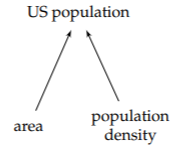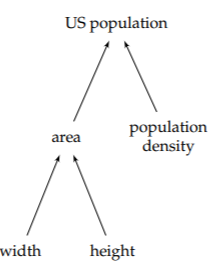1.6: Talking to Your Gut
- Page ID
- 24084
As you have seen in the preceding examples, divide-and-conquer estimates require reasonable estimates for the leaf quantities. To decide what is reasonable, you have to talk to your gut—what you will learn in this section. Talking to your gut feels strange at first, especially because science and engineering are considered cerebral subjects. Let’s therefore discuss how to hold the conversation. The example will be an estimate of the US population based on its area and population density. The divide-and-conquer tree has two leaves. (In Section 6.3.1, you’ll see a qualitatively different method, where the two leaves will be the number of US states and the population of a typical state.)

The area is the width times the height, so the area leaf itself splits into two leaves. Estimating the width and height requires only a short dialogue with the gut, at least if you live in the United States. Its width is a 6-hour plane flight at 500 miles per hour, so about 3000 miles; and the height is, as a rough estimate, two-thirds of the width, or 2000 miles. Therefore, the area is 6 million square miles:

\[3000 \textrm{miles} \times 2000 \textrm{miles} = 6 \times 10^{6} \textrm{miles}^{2}\]
In metric units, it is about 16 million square kilometers.
Estimating the population density requires talking to your gut. If you are like me you have little conscious knowledge of the population density. Your gut might know, but you cannot ask it directly. The gut is connected to the right brain, which doesn’t have language. Although the right brain knows a lot about the world, it cannot answer with a value, only with a feeling. To draw on its knowledge, ask it indirectly. Pick a particular population density—say, 100 people per square mile—and ask the gut for its opinion: “O, my intuitive, insightful, introverted right brain: What do you think of 100 people per square mile for the population density?” A response, a gut feeling, will come back. Keep lowering the candidate value until the gut feeling becomes, “No, that value feels way too low.”
Here is the dialogue between my left brain (LB) and right brain (RB).
LB: What do you think of 100 people per square mile?
RB: That feels okay based on my experience growing up in the United States.
LB: I can probably support that feeling quantitatively. A square mile with 100 people means each person occupies a square whose side is 1/10th of a mile or 160 meters. Expressed in this form, does the population density feel okay?
RB: Yes, the large open spaces in the western states probably compensate for the denser regions near the coasts.
LB: Now I will lower the estimate by factors of 3 or 10 until you object strongly that the estimate feels too low. [A factor of 3 is roughly one-half of a factor of 10, because 3 × 3 ≈ 10. A factor of 3 is the next-smallest factor by which to move when a factor of 10 is too large a jump.] In that vein, what about an average population density of 10 people per square mile?
RB: I feel uneasy. The estimate feels a bit low.
LB: I understand where you are coming from. That value may moderately overestimate the population density of farmland, but it probably greatly underestimates the population density in the cities. Because you are uneasy, let’s move more slowly until you object strongly. How about 3 people per square mile?
RB: If the true value were lower than that, I’d feel fairly surprised.
LB: So, for the low end, I’ll stop at 3 people per square mile. Now let’s navigate to the upper end. You said that 100 people per square mile felt plausible. How do you feel about 300 people per square mile?
RB: I feel quite uneasy. That estimate feels quite high.
LB: I hear you. Your response reminds me that New Jersey and the Netherlands, both very densely populated, are at 1000 people per square mile, although I couldn’t swear to this value. I cannot imagine packing the whole United States to a density comparable to New Jersey’s. Therefore, let’s stop here: Our upper endpoint is 300 people per square mile
How do you make your best guess based on these two endpoints?
A plausible guess is to use their arithmetic mean, which is roughly 150 people per square mile. However, the right method is the geometric mean:
\[best \: guess = \sqrt{lower \: endpoint \times upper \: endpoint}\]
The geometric mean is the midpoint of the lower and upper bounds--but on a ratio or logarithmic scale, which is the scale built into our mental hardware. (For more about how we perceive quantity, see The Number Sense [9].) The geometric mean is the correct mean when combining quantities produced by our mental hardware.
Here, the geometric mean is 30 people per square mile: a factor of 10 removed from either endpoint. Using that population density,
\[US \: population \sim 6 \times 10^{6} \cancel{miles^{2}} \times \frac{30}{\cancel{miles^{2}}} \approx 2 \times 10^{8}\]
The actual population is roughly 3 x 108 . The estimate based almost entirely on gut reasoning is within a factor of 1.5 of the actual population--a pleasantly surprising accuracy.
Problem 1.8 More gut estimates
By asking your gut to help you estimate the lower and upper endpoints, estimate (a) the height of a nearby tall tree that you can see, (b) the mass of a car, and (c) the number of water drops in a bathtub.


